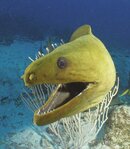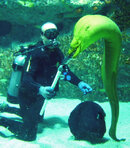I think, however, that an instructor who's been "bit several times" and believes "eel bites aren't unusual" lacks more credibility than a DM who doesnt know if morays are toxic (turns out they are, even without venom, which accounts for the unusual amount of pain and bleeding).
I have a friend named Oscar that I get to feed regularly. I've had the joy of being up close and personal with Oscar. I've had him wrap around my hear like turban. He'll hold onto your leg for leverage.
I've never heard about a Green Moray being toxic, in terms of venom. I have heard that their mouths are loaded with bacteria. I will indeed ask the aquarist about this.
What I do know about the Green Moray is they have long thin teeth, they have poor eye site, and they have a pharyngeal jaw. The have a mouth inside their mouth and that mouth has teeth. Think of alien from Aliens.
If you are bit by a Green Moray, and likely other eels as well, you're likely going to get bit on the hand and it is easy for those teeth to hit tendons.
When we are feeding Oscar and Felix, yes, 'The Odd Couple', we are very, very, very conscience of where our hands and fingers are.
Oscar, more so than Felix, knows that the divers bring him food. We have tasty mackerel, squid, shrimp, and smelt for him. 90% of the time when he sees you with that little black back, he comes to you.
We've been feeding him his whole life and we've never had a problem of a diver getting bit. We trained them to feed from a pole or to put their head in the bag and take what they want.
With that said, I'm not going to ever feed one in the wild. Oscar and Felix are well feed. We keep them well feed so they don't eat the rest of the exhibit.
If in the wild one were ever to come up to me like Oscar does, I'm going to let them swim and go where they want to go. I'm going to ball up my hands and keep them away from their head. They're going to poke around and swim off when they realize you're not food and don't have any.





